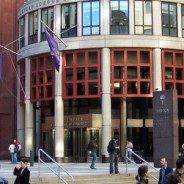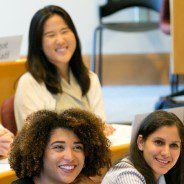Search results for :
2015-2016 NYU Stern Full-time MBA Essay Topics
Here are the 2015-2016 NYU / Stern Full-time MBA Essay Topics for applicants seeking entry in Fall 2016. This component comprises two required essays and one optional essay with a continued focus on professional aspirations and personal expression. Continue reading…
Financing Your MBA, Part II
This post has been republished in its entirety from original source clearadmit.com.
In the first of our multi-part series on financing your MBA, we took a look last week at the costs involved in attending a top-tier business school. Now, with a better handle on how much money you’ll need, let’s start looking at where that funding will come from.
Students typically rely on a mixture of savings, fellowships and scholarships, employer or outside assistance, and loans to meet the cost of an MBA program. According to the GMAC 2015 Prospective Student Survey, domestic applicants from ages 24 to 30 broadly estimate that they will rely on personal savings to finance 13 percent of their education, loans for 30 percent, and scholarships, grants or fellowships for 16 percent. Other anticipated sources of aid include parental support, spousal or partner earnings and employee assistance. Continue reading…
Affordable Healthcare Initiatives Help Healthcare MBA Grow
The Bureau of Labor Statistics has estimated that employment for Medical and Health Services Managers will increase by 23 percent from 2012 to 2022. This increase can be attributed to President Obama’s Affordable Care Act, as well as new mandates by the Supreme Court for affordable healthcare. The new standards set by these government acts, will change how the health care industry, insurance companies and private practices will deal with healthcare.
With the increase in employment opportunities, the need for qualified healthcare managers will also increase. An MBA in healthcare management can help you to learn the skills necessary to be a successful manager in the healthcare industry. According to the Bureau of Labor Statistics, healthcare managers work to improve efficiency and quality in delivering healthcare service, supervise assistant administrators, manage finances of the facility, schedule employees, serve as representatives at meetings and on governing boards and work with members of medical staff and different heads of departments.
Ashridge and KPMG Launch New Research into Women in Leadership Roles
Ashridge Business School has partnered up with KPMG in order to launch new research looking into the question of why there are a lack of women in leadership positions in Major Projects, according to a press release from the school. Along with investigating how the current state of affairs might be changed, the research plans on demonstrating the value that women could bring to some of the United Kingdom’s most important projects. Continue reading…
Financing Your MBA, Part I
This post has been republished in its entirety from original source clearadmit.com.
Getting into a top-ranked MBA program is no small feat. With application deadlines recently posted at several leading schools, many prospective applicants are laser focused now on preparing for the GMAT, submitting undergraduate transcripts and crafting perfect essays. But every bit as critical as gaining acceptance to these top programs is figuring out how you’ll manage financing your MBA once you do.
If you’ve got a spare couple hundred thousand dollars in your bank account, then you can probably skip this series. For everyone else, read on. In this post and a handful to follow, we’ll provide a broad overview of the various costs a typical MBA student faces and the types of funding opportunities currently available. Down the line, we’ll take a closer look at the financial aid processes at a diverse range of leading business schools, giving you the tools you need to assess MBA programs in light of both your own goals and available financing options. Continue reading…
A PEEK Is All It Takes: HBS’s Innovative Initiative to Woo Women
This post has been republished in its entirety from original source clearadmit.com.
For Priyanka Krishnamoorthy, a 2015 Mt. Holyoke graduate working in investment banking at Bank of America, a recent weekend at Harvard Business School (HBS) helped set her sights on pursuing an MBA. The Sri Lankan native majored in economics and minored in math and had been thinking about business school for a while. She originally read about PEEK—an innovative weekend program HBS debuted last month for students from women’s colleges—in an article in the paper. She decided to apply after attending an information session HBS held at neighboring Smith College. “They pitched it really well as a way to see what HBS is like,” she recalls. “On campus you hear a lot about PhD programs and law school, but not about business school.”
For Krishnamoorthy, the highlight of the weekend was getting to meet current HBS students and alumnae and hearing about the decisions they made both before and after business school. Just a few weeks into her own first job, she found their choices really eye-opening. “I thought there was a set path to it, but they all said, ‘No, you can come from anywhere.’” She was encouraged multiple times throughout the weekend to think of the MBA more as a master’s in leadership than a master’s in business administration. Continue reading…
Three Controversial (But Essential) GMAT Data Sufficiency Strategies
 Of all the GMAT question types, Data Sufficiency is the most unique. Consequently, it tends to be the most feared. And as a result of that, most Data Sufficiency lessons focus more on how to “get through” Data Sufficiency than on how to conquer it. GMAT students are taught vanilla strategies to play Data Sufficiency safe, and then pat themselves on the back for learning techniques to essentially read the answer choices a second or two faster (let’s be honest, the famed AD/BCE and 1-2-T-E-N strategies are really just mnemonic devices to remember the answer choices that are always written on the screen for you).
Of all the GMAT question types, Data Sufficiency is the most unique. Consequently, it tends to be the most feared. And as a result of that, most Data Sufficiency lessons focus more on how to “get through” Data Sufficiency than on how to conquer it. GMAT students are taught vanilla strategies to play Data Sufficiency safe, and then pat themselves on the back for learning techniques to essentially read the answer choices a second or two faster (let’s be honest, the famed AD/BCE and 1-2-T-E-N strategies are really just mnemonic devices to remember the answer choices that are always written on the screen for you).
The following three strategies are not intended for those trying to creep their way up to a verbal-heavy 600 on the GMAT. And the following three strategies will contradict some of what you may have read on other blogs and forums. But for those who seek the highest quant scores and who are more concerned with conquering Data Sufficiency than with enduring it, what you are about to read will be instrumental in your GMAT quantitative success.
1. Use The Statements Together
Because of the answer choices “Statement (1) ALONE is sufficient…”; “Statement (2) ALONE is sufficient…”; “Both statements TOGETHER are sufficient but neither ALONE is sufficient…”, everyone is taught to never use the two statements together unless neither is sufficient alone. Which, again, isn’t so much a strategy as a re-reading of the answer choices. And it’s not terrible advice: if you’re not careful, it’s easy to carry over some of what you read in Statement 1 and therefore think that Statement 2 is more impactful than it really is. So you should be careful to consider each statement alone so that you don’t fall victim to that mistake. Continue reading…
Carroll Dean Shares Advice in Forbes
Andy Boynton, dean of the Carroll School of Management at Boston College, recently published an article for Forbes on “trusting your gut” and how to make better decisions. The article discusses how the advice to “trust your gut” could be a brilliant decision, or could just as easily become a terrible mistake. Boynton explains that “being able to distinguish one from the other is a critical skill for a leader or anyone making a decision.”
So how does Boynton explain when and how you should trust your gut when making business decisions? He gives three rules of thumb for trusting your gut. He first explains that it is helpful to trust your gut when you are in a situation such as working in an environment that is fast-changing and data is not always the best direction to follow. Balancing the data with your instincts, explains Boynton can be a step in the right direction.
MBA
University of Baltimore MBA Program Structure
Student in the University of Baltimore Merrick School of Business have the option to take a Fully Online MBA, or a Flexible part-time MBA. Both programs offer the same curriculum, which is comprised of 36-48 credits and 11 specialization offers.
Curriculum
The University of Baltimore MBA curriculum combines the must-have skills business leaders ask for, with the freedom for students to customize their learning to fit their unique professional needs. There are six themes that are covered throughout the curriculum:
Managing Innovation and Strategy
Leading and Managing People
Interfacing with External Stakeholders
Managing the Value Chain
Managing Performance and Risk
Leveraging Technology and Business Intelligence
Additionally, the school offers dual-degree options, so students can earn their University of Baltimore Flexible MBA along with a graduate degree in another field. With evening classes at two campuses and online classes, plus traditional 15-week and accelerated seven-week formats, the school offers flexible scheduling that works for working professionals.
Class Profile
There are typically around 500 graduate business students enrolled in the Merrick School of Business and Fully Online MBA.
Tuition, Scholarships, and Financial Aid
Tuition for students in the Fully Online MBA program is $848 per credit. Cost is the same for in-state and out-of-state students.
The cost of the flexible MBA is $848 per credit for in-state students, $1,184 for out-of-state students.
Admissions
University of Baltimore Flexible MBA program applicants must have completed a four-year degree or its equivalent for admission. Work experience is not a requirement for admission. Though the majority of UB MBA students are full-time working professionals with an average of five years of work experience, the school does admit many highly qualified recent college graduates.
To apply to the UB Flexible MBA program, applicants must submit a completed application form, all college transcripts from degree-granting and non-degree-granting institutions, a current résumé, and two letters of recommendation sent directly from the writer’s email. There is a nonrefundable $35 application fee, which may be waived for those in need of financial assistance.
The UB flexible MBA also requires applicants to submit a personal statement of 1,000 words or less that outlines the applicant’s reasons for earning an MBA and why they feel they will do well in the program. Applicants to the UB Flexible MBA program must also send in their GMAT or GRE scores; however the GMAT can be waived under select circumstances; those interested should check with the school for more details.
Application deadlines are as follows:
Application Deadlines
Fall Session I: Aug. 15
Fall Session II: Sept. 15
Spring Session I: Jan. 1
Spring Session II: Feb. 1
Summer Session I: May 1
Summer Session II: May 1
Online MBA
Salisbury University Online MBA Program Structure
The Salisbury University MBA at Perdue School of Business is offered in an accelerated one-year, fast-paced format online and in a hybrid format. The courses in the program cover such topics as marketing, accounting, finance, and information systems. Graduates will be equipped with the skills they need to make good judgment calls, work in a team environment and develop business relationships. Those who wish to complete the program in a part-time format can do so in two years.
Curriculum
Salisbury University MBA students must complete an approved program of a minimum of 30 semester hours, and complete all MBA requirements within seven years of the end of the semester in which MBA coursework began. When students begin the program, they are expected to have background knowledge in foundational business topics, as well as possess standard verbal and computer skills, and basic knowledge of algebra, calculus and information systems and technologies.
In addition to the 30 credits required for the program, students may also need to complete foundation courses totaling up to 12 more credits. MBA-program courses include: Accounting Concepts and Application, Managing Strategically, Strategic Marketing Applications, Business Economics, Managerial Finance, Analytical Customer Relationship Management, and others.
The Salisbury University Online MBA can be completed in as little as nine months and be taken 100 percent online, on campus, or a mixture of both.
Class Profile
A total of 59 students are currently enrolled in the Salisbury University MBA programs, with 34 enrolled full-time and 25 enrolled part-time.
Full-time students are evenly split, with 50 percent male and female student. An estimated 26.5 percent are of minority status, and 5.9 percent are of international status. The part-time program features slightly more male students (52 percent), with 20 percent minority-status students and 8 percent international students. The average age of full-time students is 26, while the average age for part-time students is 32.
Tuition, Scholarships, and Financial Aid
All Salisbury University MBA courses are charged tuition and fees on a per-credit-hour basis regardless of the number of credit hours in which the student is enrolled. The rates are as follows:
Graduate per credit hour: $765 per credit hour.
In total, over the course of 30 credits, the Salisbury University Online MBA tuition cost is $22,950.
Students can file their FAFSA by October 1. The deadline for priority funding is March 1 and students should apply as early as possible in order to have the best chance of receiving funding.
The School of Business offers several scholarships, some of which students may be considered for automatically, and some of which require an additional application. Interested students should check with the school in order to determine the application requirements for these scholarships.
Admissions
Applicants to the Salisbury University Online MBA program must have completed a four-year degree in any field for admission. A $65 non-refundable application fee is assessed prior to application submission. Applicants are required to submit an official transcript from each college or university they attended. U.S. institutions may send official transcripts electronically or in a sealed envelope (no exceptions). Foreign Transcripts must be submitted in their original version, in English, with a GPA listed on a 4.0 scale and with credits comparable to SU credits. Otherwise, a professional course-by-course evaluation of all foreign academic transcripts is required. International applicants must have a TOEFL score of at least 550 (paper-based), a 79 on the IBT (internet based test), or an IELTS score of at least 6.5.
Three letters of recommendation are required for the, regarding professional or academic performance of MBA applicants from qualified individuals. Letters are handled via an online recommendation system that is part of SU’s online-application process. Additional application requirements include a current resume, GRE or GMAT scores and an admissions essay. Professional experience is not required. Points may be added to the formula-score totals for qualified work experience at the middle-management level or higher, with supervisory/budget responsibilities.
Application deadlines are as follows:
- Fall Priority Deadline: March 1
- Fall Final Deadline: August 1
GMAT Tip: 3 Essential Critical Reasoning Strategies
 Approximately one-third of the GMAT Verbal problems you see will be of the Critical Reasoning variety, in which you read a paragraph (or two short paragraphs representing a dialogue) of up to 125 words and then answer a question based on it. While the general instructions are relatively straightforward, there are three things you must do in order to succeed on these problems.
Approximately one-third of the GMAT Verbal problems you see will be of the Critical Reasoning variety, in which you read a paragraph (or two short paragraphs representing a dialogue) of up to 125 words and then answer a question based on it. While the general instructions are relatively straightforward, there are three things you must do in order to succeed on these problems.
1. Select the only correct answer.
The official instructions for Critical Reasoning read: “For these questions, select the best of the answer choices given.” This wording can cause some real problems for examinees who interpret it very literally. Why? Because looking for “the best” answer implies that there may be more than one “good” answer. That’s dangerous in practice, because you could look at the right answer and think “I get why that’s better than mine (but mine is still good)” and therefore overlook a fatal flaw in your thinking. This is risky on test day because it leads to your spending energy ranking or otherwise comparing answer choices more subjectively when, in reality, there is only one correct answer and the other four are definitely incorrect. Continue reading…
Stillman Center for Entrepreneurial Studies Director Shares Advice for New Entrepreneurs
Susan Scherreik, the director of the Center for Entrepreneurial Studies at the Stillman School of Business was recently featured in an article by NerdWallet. NerdWallet is a financial publication that is focused on helping people to develop the knowledge and skills needed to be successful and educated on financial matters. The article discussed the most common mistakes that new entrepreneurs make and how people can avoid making the same, or similar mistakes.
Scherreik discussed the mistake that new entrepreneurs make when they are too caught up in the idea of what their startup could be. She explains in the article that when people get too “carried away with the idea, the new entrepreneur overlooks how and when he or she can actually execute this idea and turn a profit.” She also explains to readers that “unless the idea can make money, you don’t have a business, just a money pit.”
Today’s Mobile Generation Wants Business School Admissions on the Go
This post has been republished in its entirety from original source cleardmit.com.
Business schools that aren’t meeting prospective applicants on their mobile devices and via social media may need to rethink their strategy—and fast. This according to a recent survey measuring how today’s mobile generation consumes media as part of the MBA admissions process. Results of the survey, conducted by Southwark Consulting and the Graduate Management Admissions Council (GMAC), were released last week.
“Everyone has read stories and surveys about this newest generation shifting its media consumption habits,” says Southwark consultant Alex Brown, who co-authored the study. “The interesting thing about this study is that it is the first one to specifically target people applying to or considering business school.” The survey’s 743 respondents from around the world were all registered on mba.com, the official website of the Graduate Management Admissions Test (GMAT), which is the primary entrance exam for business school applicants. Continue reading…
GMAT Tip: 3 Things to Know about GMAT Accommodations
 For a long time, testing accommodations were something to be kept secret. Test takers didn’t want schools to know they received accommodations. The process to apply for accommodations was not well publicized, and misinformation about the required documentation and when it needed to be submitted was rampant. Today, we’ll provide some valuable information for candidates who are thinking about seeking accommodations on test day.
For a long time, testing accommodations were something to be kept secret. Test takers didn’t want schools to know they received accommodations. The process to apply for accommodations was not well publicized, and misinformation about the required documentation and when it needed to be submitted was rampant. Today, we’ll provide some valuable information for candidates who are thinking about seeking accommodations on test day.
To make the GMAT more accessible to test-takers with disabilities, the Graduate Management Admission Council provides the following accommodations: additional testing time, additional or extended rest breaks, allowance of a medical device in the testing rooms, a trackball mouse, a test reader who can read the questions to the test-taker, a recorder to record test taker responses, enlarged font on the PC monitor, and a sign language interpreter. Test centers in the U.S. are also outfitted with door frames, bathroom stalls, and adjustable desks to accommodate test-takers with special needs.
While most folks would love (and would probably benefit from) extra time on the GMAT, accommodations are limited to those who have a demonstrated need, and are designed to level the playing field by making the test equally accessible to all test-takers. Per the Graduate Management Admission Council ® (GMAC®), under the Americans with Disabilities Act (ADA), a “disability” is a physical or mental impairment that substantially limits your ability to perform one or more major life activities as compared with most people in the general population.
Let’s take a look at some of the things you need to know about applying for an accommodation on the GMAT exam:
1. Start Early: Every year, there are candidates who qualify for accommodations, but who don’t submit their requests far enough in advance of their test date or fail to submit all of the required documentation. If you’re thinking about testing this fall (which is a peak time in the U.S. and many other parts of the world), start the accommodations application process now. Download the Supplement for Test Takers with Disabilities, and make appropriate appointments to get proper documentation together. Know that, it takes 3 – 4 weeks to receive a decision. If that decision isn’t what you were hoping for, you can file an appeal, but the 3-4 week window starts all over again. It’s also important to note that you’re not able to schedule your GMAT appointment until after you receive your accommodations decision, so the earlier you start the process, the more likely you’ll be to score that preferred GMAT testing appointment.
2. Know that Available Accommodations Can Vary: If you’re testing outside the United States, keep in mind that GMAT test centers are required to comply with local disability laws. If you’re testing in the United States, that’s the Americans with Disabilities Act (ADA). However, in many countries, local disability laws may be less comprehensive than those in the U.S., or nonexistent altogether. Even within a given country, the accessibility features may vary. For example, all U.S. test centers are ADA compliant for basic things such as wheelchair access. But, not all centers have a private room for a reader or may only have one workstation with an adjustable desk. If someone else who is receiving the same accommodation as you has already booked that station, you may run into trouble scheduling. You should also keep in mind that test centers are sometimes operated independently from the buildings they inhabit. For example, there was a test center in Europe that was touted for its excellent compliance with U.S. ADA standards, with wheel-chair accessible doorways, bathrooms, and desks. However, the building itself had several steep concrete stairs leading to the one single entrance… and no ramp for a wheelchair to use to access the inside of the building. This underscores the importance of researching your test center before scheduling your appointment.
3. Practice Is Still Important! Once you receive an accommodation, be it a reader or extended time, don’t forget you need to simulate testing conditions during your preparation. GMAC® has made improvements to its accommodations-friendly test prep materials over the years. In addition to 50% and 100% additional time versions of GMATPrepTM, the Official Guide for GMAT Review series is now available as a series of talking books. Make sure you’re practicing and pacing yourself with the appropriate amount of time, or if you’re using JAWS software for the Analytical Writing Assessment, do so during your practice tests.
So, as you’re settling into summer and starting to hit the GMAT prep books, if you’re thinking of applying for accommodations, take advantage of a study break and make sure you’re staying on top of this equally important application process. Remember, schools don’t see whether you received accommodations (including extra time) on your GMAT exam, so if you do qualify for an accommodation, make sure you’re doing everything you can to achieve success on test day.
The above article comes from Veritas Prep. Since its founding in 2002, Veritas Prep has helped more than 100,000 students prepare for the GMAT and offers the most highly rated GMAT Prep course in the industry.
GMAT Tip: 3 Things to Know About Picking a GMAT Test Center
 While deciding to take the GMAT is a big decision in itself, there are a series of smaller choices that might make a big difference in your outcome on test day. One of those is the facility factor. Not all GMAT test centers are created equal, so read on for some quick tips to ensure you’re setting yourself up for success on test day!
While deciding to take the GMAT is a big decision in itself, there are a series of smaller choices that might make a big difference in your outcome on test day. One of those is the facility factor. Not all GMAT test centers are created equal, so read on for some quick tips to ensure you’re setting yourself up for success on test day!
1. Size Matters: You would never buy a car or house by just looking at a picture and name. You have to take it for a test drive and see if it’s right for you. Just like cars, test centers come in a variety of makes and models. They can have as few as 2 or as many as 15 work stations, and they can offer up to 15 other exams (in addition to the GMAT). While the number of work stations might not seem relevant (you only need one!), remember there is only one proctor who has to keep tabs on everyone. Chances are you’ll get a quicker response to requests for a new noteboard or tissues if there are fewer candidates in the room.
2. Early AM Coffee or Happy Hour: Anyone who took the SAT or ACT in high school will recall that you didn’t have options when it came to test day. You crammed into a high school classroom — or gym — with 30-300 other students on a Saturday morning and hoped your #2 pencils held out. With the GMAT, there’s considerable diversity in terms of the appointments offered. Just like some folks prefer red eye flights, some test takers love 8:00 AM appointments. Check out the “Find Test Dates” feature on mba.com that lets you peruse available appointments in real time without making a commitment. (Think of it as the Tinder of the standardized testing world.) “Find Test Dates” lets you view six months of available GMAT appointments at up to 10 test centers near you so you can identify which centers cater to the early birds and which are more geared toward for Happy Hour.
3. 30 day challenge: No this isn’t a 30 day diet plan or challenge, but did you know that GMAC® guarantees that you’ll be able to find an appointment within 30 days at any test center around the globe? It might not be your first choice, but there will always be available appointments. Just remember: if 1:00 PM on a Sunday afternoon sounds attractive to you, it probably sounds appealing to some of the other approximately 200,000 test takers who take the GMAT each year. Appointments are updated in real-time on mba.com, so if at first you don’t see an appointment you love, check back. (NB: GMAC releases appointments six months in advance, so plan early and score an appointment date and time that’s most convenient for you.)
Like so many things in life, there are fees involved here, so make sure you do your research, think through your schedule, and plan your test prep timeline and method before making a commitment. You’ll pay $50 to reschedule if you should have to change your appointment – and will forfeit your entire $250 fee if you cancel within a week of the test date. As you can see, there’s quite a bit to consider in selecting a test center, so spend a little bit of time in between study sessions researching the site best for you. Hitting the books will prepare you for what you see inside the test center, but you want to set yourself up to succeed from every perspective on test day.
The above article comes from Veritas Prep. Since its founding in 2002, Veritas Prep has helped more than 100,000 students prepare for the GMAT and offers the most highly rated GMAT Prep course in the industry.
How to Create a Competitive Admissions Application
Students decide to enroll in an MBA program for multiple reasons. Some students seek the knowledge needed to progress their careers, while others look to gain the skills to build a successful new business. Whatever the reason, the process begins with doing the proper research to find out which program is best for the student. The Economist says, “Finding the right school is not just about looking at rankings, or choosing one considered as “prestigious.” The key to making the right choice is, understanding why you want to take an MBA, and what you expect it to do for you.”
Wherever you start your search, the last step will be to complete the application process for the program or programs you choose. The application process varies by schools but typically includes completing the actual program application, the submission of required documents, such as GMAT scores and undergraduate transcripts, letters of recommendation, a copy of their professional resume and often, a statement of purpose and sometimes an admissions interview.
Executive MBA
Southern Methodist Executive MBA Program Structure
The Southern Methodist University Executive MBA Program at The Cox School of Business is a 21-month part-time program designed for experienced business leaders looking to take their career to the next level. Classes for this program are held Fridays and Saturdays on alternating weekends. Friday classes are held in a morning session and an afternoon session. The program is conducted in a cohort structure.
Curriculum
Students in the Executive MBA program will receive an education that emphasizes general management practices. The program also emphasizes strategy and finance. During the first half of the program, students will cover an array of business skills. In the second half they will focus on real-world applications.
Students in the Executive MBA program participate in a global studies trip. During the trip, students get to witness and experience the business practices and political climate of the country that they are in first hand.
Students also have the opportunity to participate in business plan competitions and pitch their business ideas to angel investors and venture capitalists through the program’s entrepreneurship course.
Class Profile
The Executive program at SMU Cox attracts successful business leaders with an average of 15 years of professional work experience and nine years of management experience. There are typically 60 to 70 students enrolled in the EMBA program. The average age of Executive MBA students is 37.
Careers
The Southern Methodist Executive MBA program at The Cox School of Business prepares business leaders to move into higher executive level positions or to expand their company’s reach. Students in the EMBA program have access to career management resources such as resume review, career counseling, industry information sessions, mock interviews, networking events, executive mentoring and Cox student and alumni groups.
Students also have access to the Business Leadership Center. The BLC offers specialized training in leadership, communications and interpersonal skills. EMBA students also have access to The Cox Associate Board, which gives students the opportunity to meet successful business leaders and work one-on-one with one of the school’s 200 executive mentors.
Students also have access to the Career Management Center. The CMC provides career advisory services such as career assessment, planning, resume review, and coaching.
Tuition, Scholarships, and Financial Aid
The tuition for the Southern Methodist University EMBA program is currently $121,825. The tuition covers the cost of academic cases, use of the Business Information Center, parking, meals on each class day, lodging, some airfare and some meals associated with the required global trip. In addition, students must also pay a $2,800 nonrefundable payment (not applied towards tuition) that guarantees their place in the class after acceptance to the program.
Students pay their tuition costs over five installments. Some financial aid and scholarship opportunities are available for students in the Executive MBA program at Cox. The school also accepts private funding and veteran’s benefits to cover the cost of tuition. Those interested in more information on the financial aid available can email a financial aid counselor at gradfinaid@smu.edu or call 214-768-4908.
Admissions
In order to be considered for admission for the Southern Methodist Executive MBA program at the Cox School, applicants can first send their resume and a cover letter to dteems@cox.smu.edu in order to schedule an initial phone interview.
After the phone interview is completed, applicants should complete the online application form and send a copy of their current resume and cover letter, all official undergraduate and/or graduate transcripts, answer the two essay questions and complete the action plan (found on the online application) and provide two letters of recommendation (one from a senior manager of the sponsoring company and one from an immediate supervisor or colleague with an MBA).
Once all application materials have been received, the Executive MBA office will contact the applicant for an in-person interview, if appropriate. An admissions decision will be given within two weeks of the interview.
Prospective students are required to have at least eight years of professional work experience. The GMAT/GRE is not required for this program.
Key Dates & Deadlines – Fall 2022 |
| January 24, 2022 – Early Decision Deadline* |
| March 31, 2022 – Priority Scholarship Deadline |
| May 16, 2022 – Regular Decision Deadline |
| August 1, 2022 – Final Deadline |
| *Applicants who apply by the first deadline will automatically receive a $5,000 scholarship if admitted. |
Applications are admitted on a rolling basis.
Professional MBA
Southern Methodist Professional MBA Program Structure
The Southern Methodist University Professional MBA program at the Cox School of Business is a 24-month (50 credit) program designed for working professionals with a minimum of two years work experience. Classes for this program are held in the evenings and on weekends to accommodate the busy schedules of working professionals.
Curriculum
The Southern Methodist Professional MBA features a flexible and modular curriculum that students can customize to their learning and future career goals. Students have the option to choose a concentration and a minor from nine subject areas.
Concentration and minor options include accounting, finance, general business, information technology and operations management, management, marketing, real estate and strategy and entrepreneurship.
Students spend the first three terms completing the foundational coursework, which will give students the knowledge needed to be successful in the business world. The last three terms are spent completing courses in a student’s chosen concentration to complete the MBA and/or an additional minor.
Students can also participate in an international exchange program with one of Cox’s partner schools in such locations as Hong Kong, Denmark, China, Germany and Italy.
Class Profile
The Class of 2020 Professional MBA intake at SMU Cox is made up of 108 students. The average age of students is 28. The class is 44 percent female and 56 percent male. Students in this program have an average of six years of professional working experience and an average GMAT of 610. Twelve percent of the class is international.
The Cox school does not require students to have an undergraduate business degree. However, 50 percent of students in the program studied business or economics as an undergraduate. Other students possess undergraduate degrees in a variety of areas such as engineering, social sciences, humanities and science.
Tuition, Scholarships, and Financial Aid
The estimated total cost of the SMU Cox Professional MBA program is $96,624. This includes tuition and general student fees for the two years of the program. This estimate excludes any other costs that students may endure –for example, books, materials, housing or transportation.
Approximately 60 percent of Southern Methodist Professional MBA students receive some form of financial aid, either need-based or consumer loans. The Cox School accepts all forms of financial aid: scholarships, private loans, grants and veterans benefit programs.
The Admissions and Financial Aid representatives at the school are available to help students to move through the process of securing all necessary funding to attend the Cox PMBA program.
Admissions
Applicants must complete the following steps for their application:
Submit the application forms found in the online application, provide a copy of their professional résumé, complete three essays (topics available online), submit GMAT or GRE scores, provide copies of degreed undergraduate transcripts and provide two professional references (names and contact information only).
Applicants for the PMBA program are required to take the GMAT. The GMAT range for admitted students is between 590 and 710.
Successful applicants for the program typically have several years of postgraduate work experience, although a minimum of only two years is required. Students should also have a strong undergraduate academic record, and competitive scores on the GMAT. Applicants are also expected to be computer literate, with a basic understanding of MS Office products and the Internet. It is also recommended that applicants also have a working knowledge of calculus, accounting, statistics and microeconomics.
Key Dates & Deadlines |
||||
Spring 2022 |
Fall 2022 |
|||
| August 9* | October 25* | |||
| September 13 | December 6 | |||
| October 11 | February 7 | |||
| November 15 | April 11 | |||
| June 6 | ||||
| *Applicants who apply by the first deadline for each entry term will automatically receive a $2,500 scholarship if admitted. | ||||
* = All applications submitted after June 1 are reviewed on a rolling basis.












